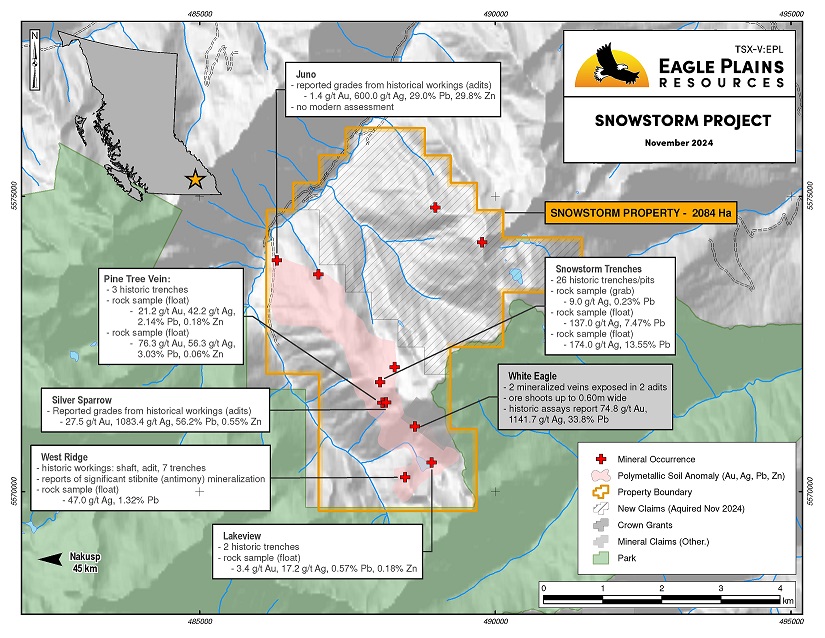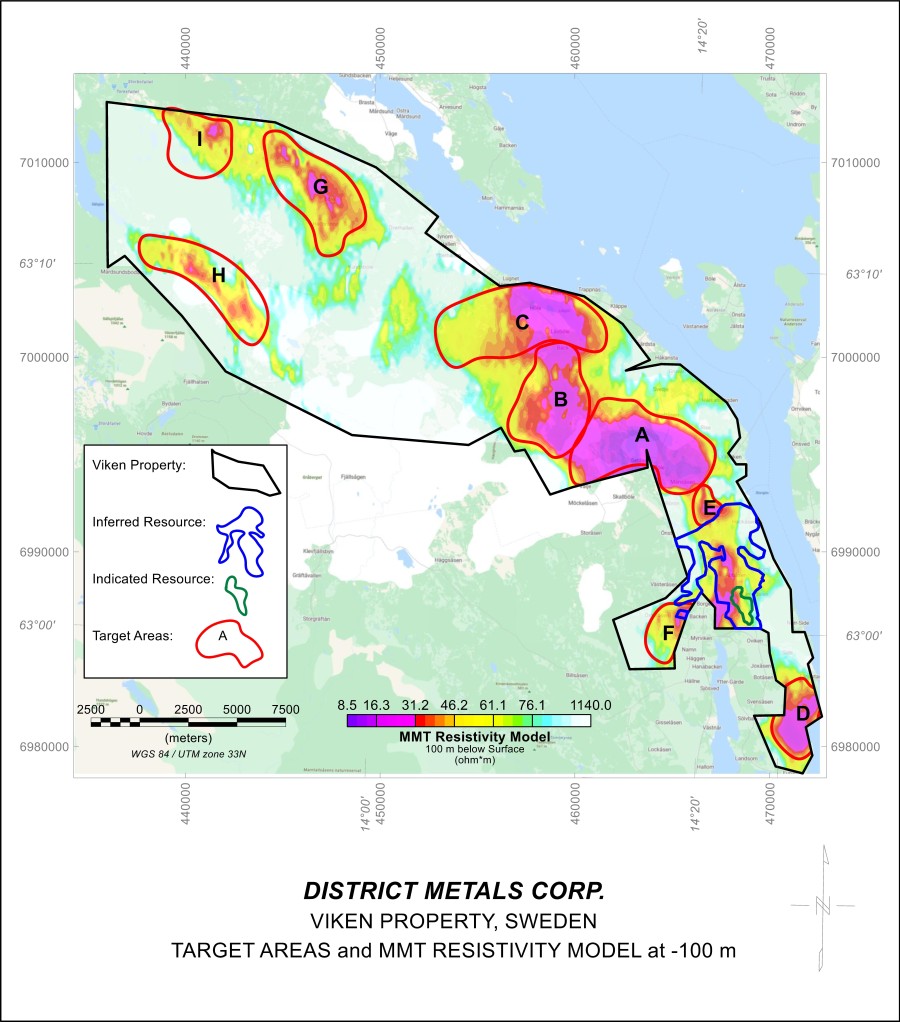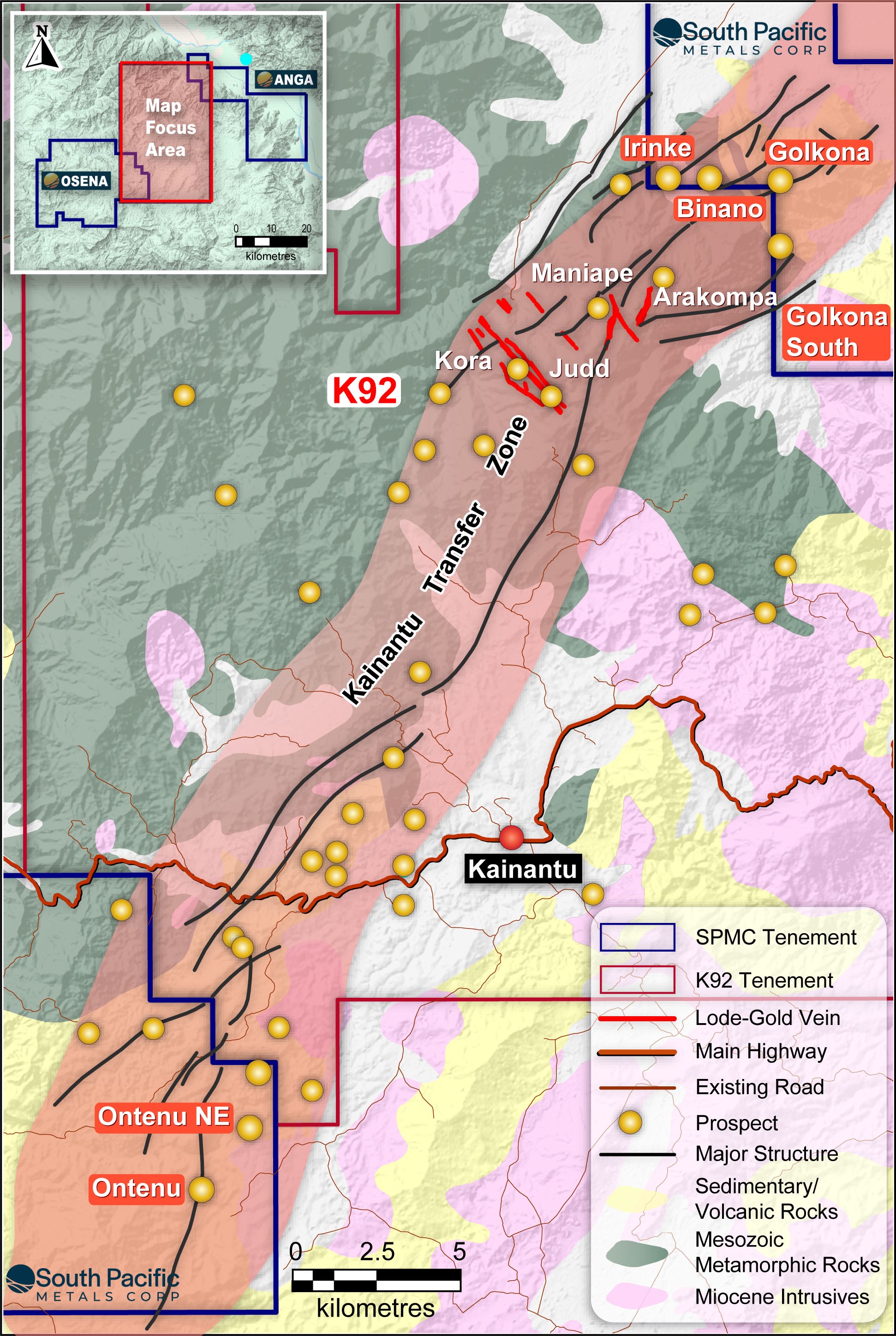Nov. 8, 2016 - Mineral Mountain Resources Ltd. ("Mineral Mountain" or the "Company") (TSX VENTURE:MMV) reports that the proprietary Standby Mine database announced in a news release dated October 3, 2016, combined with the Company's comprehensive database for the 3 km long Cochrane Trend, both point toward large-scale ledge-type high grade gold targets with estimated extensive down plunge lengths of up to 3.0 kilometers. The Company has engaged the services of FMG Engineering based in Rapid City, South Dakota, to initiate the permitting process to drill 20,000 meters of core drilling to test both targets.
Highlights:
- Standby Mine Trend:
- Historic drill hole SM87-3A, 10.29 g/t Au over 3.05 m, 1400 m laterally and 1600 m down plunge* *(distances measured from historic Standby Mine surface workings, along surface and also down the structural plunge of the iron formation)
- Historic drill hole BLG-UG3, 4.61 g/t Au over 12.19 m, 130 m laterally and 250 m down plunge
- Historic drill hole SM86-1, 2.02 g/t Au over 14.0 m, 600 m laterally and 780 m down plunge
Standby Target Trend
In October, 2016 the Company purchased a proprietary digital database, generated from core diamond drilling conducted by Homestake Mining Company between 1967 and 1988 and, never released to the public, consisting of 71 diamond drill holes totaling 22,394 meters, of which 17 holes totaling 14,723 meters targeted a Homestake-style, 9-Ledge scale Proterozoic iron formation synclinoral fold structure at the Standby Gold Mine Property (see September 12, 2016 release). A longitudinal section of the Standby Target Trend was generated by Homestake Mining Company and is posted on the Company's website www.mineralmtn.com, This major synclinoral fold structure was considered by Homestake to be large enough to host a district scale gold resource similar to the Homestake District and the Homestake Mine. At the Homestake Mine, eleven ore "ledges", a local term for gold-mineralized plunging iron formation fold structures, accounted for the 40 million troy ounces of gold produced, with 9-Ledge alone having produced 9.5 million ounces.
Between 1986 and 1988, Homestake drilled three separate "widely spaced step out" fences comprising trunk holes and numerous splays, along cross sections down plunge from the Standby Mine shaft. The "step out" cross sections were designed to intersect the major gold bearing iron formation fold structure at 750-meter intervals down plunge. Remarkably, in 1987, Homestake SM87-3A, located 1400 meters laterally (560 meters vertical depth from surface) and 1600m down plunge from the historic Standby Mine Gold Deposit intersected a broad interval of gold mineralization within a thick, tightly folded unit of iron formation, including a high grade interval grading 10.29 grams per tonne over 3.05 meters. Near the Standby Mine workings, an underground drill hole, designed to test the down plunge extension of the gold mineralization extracted from the mine, intersected 4.61 grams per tonne over 12.19 meters in iron formation within the major fold structure. This intersection cut the Standby Target 130 m laterally and 260 meters down plunge from the surface workings of the Standby mine. The earliest deep fence of drill holes completed by Homestake in 1986, designed to intersect iron formation 780 meters down plunge from the Standby Mine, intersected six significant gold intersections with a broad mineralized system. The widest gold intersection was recorded in SM86-1 which cut 2.02 grams per tonne over 14.0 meters. The Company is planning to drill 10,000 meters specifically to target the 1500 meter long plunge potential between the high grade gold intersection in SM87- 3A up-plunge toward the Standby Mine mineralization, and also to follow-up the high grade intersection in SM87-3A toward the interpreted deeper underlying synclinoral axis.
Cochrane South Trend
- Drill hole NM-96-7, 10.05 g/t Au over 5.03 m and 10.25 g/t Au over 2.44 m, (2 parallel gold Au zones), 175 m down plunge from historic Cochrane Mine
- NM-96-5, 9.86 g/t Au over 2.74 m
- Trench 1, 9.94 g/t Au over 7.62 m and 4.04 g/t Au over 6.01 m (2 parallel Au zones)
- CR88-2, 7.99 g/t Au over 10.67 m, 6.96 g/t Au over 13.72 m (2 parallel Au zone)**
- CR88-7, 8.26 g/t Au over 7.16 m**
- CR89-25, 6.24 g/t Au over 7.74 m
- **(approximately 50m-100m vertical depth, north side of historic Cochrane Mine)
The Cochrane Deposit and the adjoining Cochrane South Property occur within a 3 km long major structural corridor that hosts near surface Homestake-style ledge gold mineralization. The most advanced gold zone along this trend is the Cochrane Deposit which is estimated to host, based on drilling by Noranda, Getty, Newmont and Naneco Resources an in-house non- compliant NI43-101 resource estimate of 68,000 ounces of gold in the indicated category and 200,000 ounces of gold, in the inferred category, grading a combined 6.34 g/t Au to a depth of 165 meters. A qualified person has not done sufficient work to classify the above historical estimate as current mineral resources or mineral reserves, and Mineral Mountain is not treating the historical estimate as current mineral resources or mineral reserves. The Ledge-style gold mineralization in Cochrane Deposit is open at depth and, based on a number of high grade intersections within a 30 m wide, structurally thickened unit of altered iron formation drilled 100 meters from the common boundary between the Cochrane patents and the Company's Cochrane South Property, the gold-bearing structural corridor that hosts the near surface deposit plunges onto the Company's property.
Two drill holes completed by Naneco, between 1996 and 1997, intersected the down plunge extension of the Cochrane Deposit between the lower limits of the non-compliant near surface resource and within 100 meters from the South Cochrane Property boundary. Drill hole NM96-5 intersected 9.86 g/t Au over 2.74 m and two separate high grade mineralized intervals were cut NM96-7 grading 10.04 g/t Au over 5.03 m and 10.25 g/t Au over 2.44 m. The latter drill hole NM-96-7 is only 150 m from the Cochrane Project/Cochrane South common boundary. Near surface within the Cochrane Deposit, two trenches exposed two parallel zones grading 9.94 g/t Au over 7.62 m and 4.04 g/t Au over 6.01 m. Directly below these trenches, drill hole, CR88-2 intersected two separate and parallel gold zones grading 7.99 g/t Au over 10.67 m and 6.97 g/t Au over 13.72 m. Drill holes CR88-7 and CR89-25 intersected 8.26 g/t Au over 7.16 m and 6.24 g/t Au over 7.74 m respectively in the eastern most parallel zone.
Mineral Mountain's technical team has interpreted the shallow, near surface Cochrane Deposit mineralization to be comparable to an "upper tail" position in typical gold-ore ledges at the Homestake Mine. The goal is to trace the mineralization down plunge to discover a potential high grade, multi-million ounce ledge-type ore centroid. A 10,000 m drill program has been planned for this prospective target.
The Rochford Gold District is centered approximately 26 kilometers south of the world's largest iron formation hosted gold deposit, the Homestake Mine, which produced over 40,000,000 ounces of gold from 152 M tonnes of ore averaging approximately 8.4 g/t Au (0.245 opt) over the life of the mine from 1876 to 2001.
The geology of the Rochford District is remarkably similar to that at the Homestake Mine with gold hosted in multiply deformed Proterozoic carbonate facies and locally sulfide-facies iron formation that has typically been metamorphosed to cummingtonite/grunerite phyllites/schists and chlorite schists. There are numerous, relatively shallow, high-grade past producing gold mines and prospects in the district that were developed in the late 1800's and early 1900's. Mineral Mountain's property package covers the approximately 9 km long by 5 km wide core of the district, with multiple trends of locally structurally thickened and sheared auriferous iron formation considered to have many geological and mineralogical aspects in common with the Homestake Mine, 26 km to the northwest.
The Rochford Gold Belt covers more than 78 square kilometers and has been explored intermittently, but never comprehensively nor systematically to depth, by a number of major companies including Getty, Cominco, Newmont, Noranda, Western Mining and Homestake Mining in the 20th century. Despite gold prices hitting $1,900 US per ounce in 2011, the last serious exploration in for the Rochford District was completed in 1997.
Qualified Persons
The technical information in this news release has been prepared in accordance with Canadian regulatory requirements set out in National Instrument 43-101 and reviewed and approved by Nelson W. Baker, P.Eng., the President and CEO of Mineral Mountain Resources Ltd. and a Qualified Person for this project. All exploration activities at the Rochford Project are carried out under the supervision of Kevin Leonard, P.Geo., also a Qualified Person for this project.
About Mineral Mountain Resources and the Rochford Gold Project
Mineral Mountain Resources Ltd., through its wholly owned subsidiary Mineral Mountain Resources (SD) Inc., is focused on the exploration and, if warranted, development of its 100%- owned Rochford Gold Project situated along the highly prospective Homestake Gold Belt in the Black Hills of South Dakota, U.S.A. The Rochford Project covers approximately 7,500 acres and straddles three major trends of structurally thickened auriferous iron formation that host ledge-type gold mineralization.
Since 2013, the Company has continued to expand its land position in the Rochford gold district by professional claim staking and also by purchasing strategically located private properties that fall along two of the major sub-parallel structural trends that host Ledge-type gold mineralization. The Company now owns the largest land position in the Rochford greenstone belt and now possesses by far the largest and most comprehensive database for the district in modern day exploration history! The Rochford Project is vastly under-explored and has the potential to host several district scale gold discoveries.
Source: Mineral Mountain Resources





